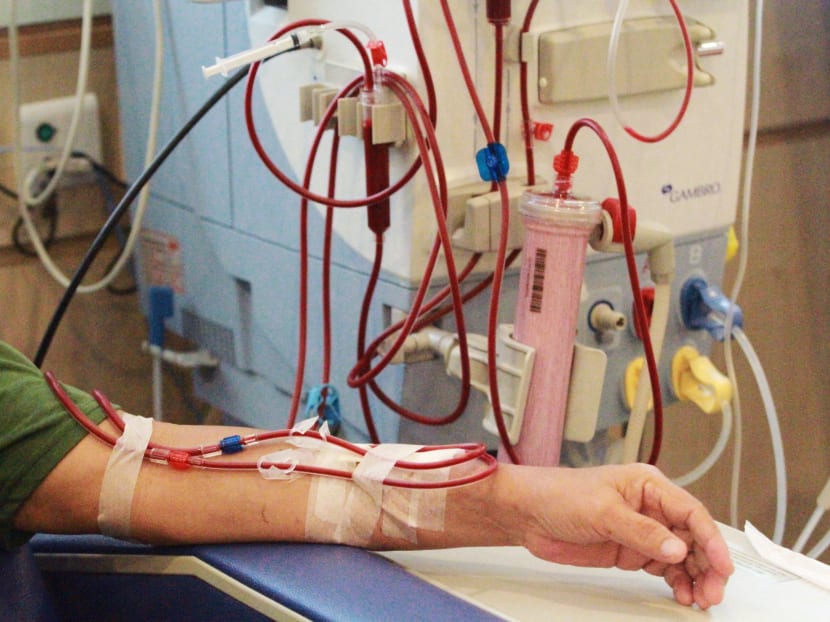The case for preventing diabetes over cure
As we mark World Diabetes Day on Tuesday (Nov 14), it is timely to review the fight against diabetes, especially in Singapore.

A diabetic patient undergoing dialysis treatment at NKF Kim Keat Dialysis Centre. The first step to preventing Type 2 diabetes is to live an active life. TODAY file photo
As we mark World Diabetes Day on Tuesday (Nov 14), it is timely to review the fight against diabetes, especially in Singapore.
“If you look at yourself, and at the person sitting to your left, person sitting to your right, most probably at least one of you will have diabetes one day,” said Prime Minister Lee Hsien Loong at the National Day Rally in August.
According to the International Diabetes Foundation (IDF), Singapore has one of the highest incidences of diabetes among developed countries, trailing behind only the United States. One in nine Singaporeans aged between 20 and 79 are diabetic, and this number increases further with age, with three in 10 Singaporeans aged over 60 suffering from the disease.
While worrying, these findings are hardly surprising, as Singaporeans have become more sedentary and less active over time, just like other high-income countries.
And contrary to popular belief, the more common type of diabetes is Type 2 diabetes – a lifestyle disease arising from poor diets and the lack of exercise.
This marks a stark contrast against the cause of Type 1 diabetes – an auto-immune condition where the body becomes resistant to insulin and loses its ability to produce enough insulin, leading to high blood sugar levels.
Type 1 diabetes is also largely believed to have genetic links, but the underlying cause still baffles scientists and researchers today.
In fact, over 90 percent of diabetics suffer from Type 2 diabetes, which develops over a two to 10 year period after high levels of blood sugar are recorded.
Studies done at multiple US centres and funded by the National Institutes of Health showed that 58 per cent of new cases of diabetes over the last the five years could be prevented with a simple programme of controlled diet and regular exercise.
Type 2 diabetes is also especially common in Asians. A 2013 study on “Global obesity: trends, risk factors and policy implications” reported that 60 per cent of the world’s diabetic population are Asian.
This perhaps reflects a genetic tendency to have less muscle and more accumulation of abdominal fat when exposed to lifestyle factors such as reduced exercise, eating white rice and other refined grains that deliver “empty calories” with little nutritional value and the rising consumption of fast food.
All across the world, the prevalence of Type 2 diabetes is predicted to increase by 54 per cent between 2010 and 2030. With Asia at the epicentre of this epidemic, there is a pressing need for us to take active steps to prevent the onset of this chronic disease by making changes to our everyday living habits.
PREVENTING TYPE 2 DIABETES
The first step to reducing our chances of getting Type 2 diabetes is to live an active life. As Type 2 diabetes is often linked to obesity and overweight, the role of exercise is critical here.
Incorporating just 30 minutes of moderate physical activity each day, five days a week, can provide significant health benefits by reducing blood sugar levels and boosting the effectiveness of insulin in your body.
If time is a challenge, split the exercises into three 10-min blocks to be done during different parts of the day. As PM Lee said, simple measures such as using the stairs or going for brisk walks will help too.
A second tip is to be more conscious of what you consume on a daily basis, and make an effort to practise balanced nutrition in everyday living.
The ideal calorie composition should comprise of 40 per cent carbohydrates, 30 per cent protein and 30 per cent healthy fats, coupled with 25 grams of fibre and eight glasses of water per day.
Here, “healthy fats” refer to less omega-6 fats - which are derived from processed foods and vegetable oils other than olive oil - and more omega-3 fatty acids. Whole grains, fish, spices and nuts are excellent sources of healthy fats that you can incorporate easily into a healthy and balanced diet.
Finally, don’t underestimate the importance of regular health screenings. The IDF estimated that as many as 193 million people, or close to half of all adults living with Type 2 diabetes, are unaware that they have the disease. Early health diagnosis can help to detect early symptoms and signs for the disease, which can lead to early introduction of measures to prevent the onset of Type 2 diabetes.
With the recent introduction of S$5 health check-ups for those above 40 years old, the high cost of going for health screenings should no longer be an excuse.
While these lifestyle changes sound simple and familiar – they have the ability to put us on track to live a healthy life ahead of us – one that is free from diseases and particularly, Type 2 diabetes. Unlike the majority of diseases, it is possible to reduce the risk of getting Type 2 diabetes. It all boils down to personal choices and discipline.
ABOUT THE AUTHOR:
Dr David Heber is the Chairman of the Herbalife Nutrition Institute. He is the Founding Director of the Center for Human Nutrition at the University of California, Los Angeles and the author of four books.






